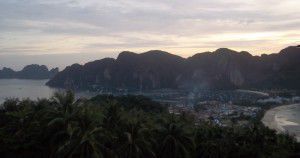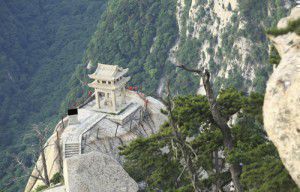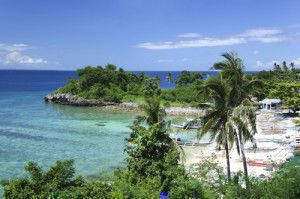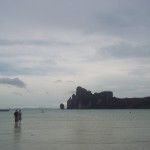10 of the world’s most amazing places
One of our top tips for learning a language is to take a holiday – it not only gives you a chance to practise your new language with the locals but you also get to visit somewhere nice. And why not take the opportunity to visit some of the world’s most amazing (if sometimes slightly bizarre) places while you’re at it?
1. San Alfonso del Mar
Like the world’s largest swimming pool, for instance, which is at San Alfonso del Mar in Chile. If you’re thinking of swimming lengths, you might want to stock up on energy drinks before diving in to this one. It’s more than 1,013 metres long, so paddlers should beware! It also has a 35-metre deep end – not for the unwary swimmer. The Guinness Book of Records named this pool as the biggest in the world, needing 66 million gallons of water to fill it up.
2. Mt HuaShan
Or maybe you’d like to visit a traditional Chinese tea house. What about this one, at the top of Mt. HuaShan? It’s 2,160 metres high and the path to get there is nothing short of terrifying. It’s thought that there may be as many as 100 fatal falls a year, and yet the trail is popular with tourists, keen to visit the teahouse, on the southern summit of the mountain, which used to be a Taoist temple, or the chess pavilion on the east peak.
3. Stewart Island
If bird-watching is your thing, you could visit Stewart Island in New Zealand. It’s one of the most remote destinations in the world, with only one town, Halfmoon Bay (also known as Oban) and an estimated population of just 450 people. The island is the only place to see the Kiwi bird in its natural habitat and is also home to five species of penguin.
4. Pink Lake
Next door in Australia, Pink Lake, just west of Esperance, is worth a visit. As its name would suggest, in certain weather conditions the water in the lake is pink, thanks to a particular kind of algae in the water. And this isn’t the only pink lake in the area. Lake Hillier, on Middle Island, is another example and an even brighter colour.
5. Joffre Lakes
However, if you prefer your lakes blue, the Canadian park of Joffre Lakes in British Columbia comes highly recommended. The lakes are a more traditional, but stunningly beautiful, turquoise blue and surrounded by peaks and glaciers. A trip to Joffre Lakes isn’t complete without an overnight stay, where you can camp under the stars and listen to the ice calving from the glacier.
6. Kizhi
The Russian island of Kizhi is found almost exactly at the centre of Lake Onega and boasts a spectacular wooden church, the Church of the Transfiguration, which was built in the 18th century without a single nail. Legend says that the lead builder used just one axe for the whole building, and then threw it in the lake when the church was completed, saying, ‘There was not and will not be another one to match it.’
7. Kayaköy
Just a few miles from the popular resort of Fethiye in southwestern Turkey, on the side of a mountain, is the village of Kayaköy. Greek-speaking Christians lived there until the 1920s but the village was abandoned follow a population exchange agreement between Turkey and Greece in 1923. Now a museum and historical monument, Kayaköy is a beautiful but rather eerie ghost town.
8. Capuchin monastery
Speaking of eerie, the Capuchin monastery in Sicily is home to 8,000 mummified corpses in the monastery catacombs. The bodies are all dressed in their best clothes and arranged in different rooms according to the type of person. The oldest in the collection dates from 1599, while the most recent addition is the body of Rosalia Lomabardo, who was embalmed in 1920 and is known as ‘Sleeping Beauty’.
9. ICEHOTEL
If you’re looking for somewhere a bit different to stay, you could try the ICEHOTEL in Jukkasjärvi, Sweden. Made with ice from the Torne River, the hotel offers ice and snow rooms, and runs a survival course every night for new guests on what to wear and how to cope when sleeping in temperatures below zero. But don’t worry – warm rooms are also available if you’re not a fan of the cold.
10. Malapascua
One extreme to the other – the island of Malapascua in the Phillippines boasts beautiful beaches and is most popular with divers, as it’s the only place in the world to see the pelagic thresher shark. There’s no transport on the island because it’s small enough to walk everywhere, and the only way to arrive on the island is by banca (a local boat ferry).
We hope that’s given you a few ideas for your next holiday. Don’t forget to learn a few words in the local language before you leave! And if we missed your favourite place, let us know in the comments…
Know Your Colour Code
Here at EuroTalk we love discovering interesting facts about the world around us, so from now on, on the third Wednesday of each month (or thereabouts!) we’ll be sharing some of these with you. The theme for this month is colours…
Be a man: be yellow
If you call someone ‘yellow’ in England, you’re calling them a coward. In Japan, the opposite is true; yellow is the colour of courage, and while Westerners usually see pink as a feminine colour, in Japan it’s very masculine; it conjures up the memory of fallen samurai.
Poisoned Pens
In China, writing someone’s name in red is unlucky and it usually means you want to cut them out of your life; just make sure you don’t have red ink on your hands if something bad happens to them!
Feeling blue? You’ll regret it in the morning…
In English it’s fairly common to say you’re ‘feeling blue’ if you feel sad. But in Germany, to be blue (‘blau sein’) is to be drunk.
White: it’s the new black
Weddings in the West are all decked out in white, but the same is not true of China, where white is the colour of mourning. Instead, brides wear red, as the colour symbolises good luck.

Purr-fect Opposites
In many cultures, a black cat is seen as lucky: in Japan, it’s believed to attract suitors, and in Scotland a cat arriving at your home is a sign of prosperity coming your way. But in America, the same animal is considered bad luck, particularly by gamblers on their way to the casino.
Colourful Confrontations
Useful information if you find yourself in a fight in Europe… In English, the result might be known as a ‘black eye’, whereas in Germany it’s blue (‘blaues Auge’), in Spain it’s purple (‘ojo morado’) and in France it’s known as an ‘oeil au beurre noir’ (literally ‘eye in black butter’)!
If anyone has any other examples of colour-related facts, we’d love to hear them!
A Lonely Planet?
Ask your grandparents where they went on their honeymoon and the vast majority will answer that they went to some seaside town within their own country. My grandparents for instance went to Scunthorpe, and by all accounts had a brilliant time. Now look at the destinations of the people who have recently been married around you, or those just heading away for a trendy city break or backpacking around the globe. Just in our office alone I am sure we can cover most of a world map with little flags signifying the countries we have visited. My point? The world appears to be shrinking and with it comes a certain amount of damage to areas of unprecedented beauty and to some of the many wonders of the world.
 In certain cases an increase in popularity or accessibility can lead to a few oddities, and fun, if unsympathetic activities. For example, in China at the UNESCO protected site of Mutianyu, what better way to place yourself in the shoes, or sandals, of the Mongol hordes than tobogganing down the side of the Great Wall of China? The same occurs at the site of the bridge over the river Kwai. The museum explains the history of the Burmese railroad, the numbers who died in its construction and the events portrayed in the 1957 film. You can then ride across the bridge on a traditional garishly rainbow coloured, road worthy train. Small gripes I know but are we not losing the significance of these sites by diluting them with fairground distractions? Or do these attractions simply add to the entertainment value of an area?
In certain cases an increase in popularity or accessibility can lead to a few oddities, and fun, if unsympathetic activities. For example, in China at the UNESCO protected site of Mutianyu, what better way to place yourself in the shoes, or sandals, of the Mongol hordes than tobogganing down the side of the Great Wall of China? The same occurs at the site of the bridge over the river Kwai. The museum explains the history of the Burmese railroad, the numbers who died in its construction and the events portrayed in the 1957 film. You can then ride across the bridge on a traditional garishly rainbow coloured, road worthy train. Small gripes I know but are we not losing the significance of these sites by diluting them with fairground distractions? Or do these attractions simply add to the entertainment value of an area?
In Thailand I also visited Koh Phi Phi, a small island chosen as the location of The Beach, a Leonardo Dicaprio film and book by Alex Garland, which portrayed a utopian island experience far away from the western confines of the mass backpacker route. 
Ironically the setting for this isolated paradise is now one of the most visited areas in Thailand and ’the Beach’ is now thronged with noisy tourists; the Andaman waters are now gleaming because of the residue left from the flotilla of tourist-packed speed boats that arrive at the location twice a day. Despite the numbers of tourists, ‘the Beach’ topped almost all guide books as a must-see, and whether I had been there was the first question fielded from friends at home. In the end it was simply a ticked box rather than a once in a lifetime experience.
What I am trying to determine from these small examples are the opinions of other tourists and travellers. I wanted to go somewhere because it was famous. People have heard of ‘the Beach’ and everyone knows about the Great Wall of China. But should the accessibility to these locations be limited? Is accessibility a good thing?
The example I want to finish on is Tibet. An area known by most people as a far outpost of China, an area little visited due to its isolation from, well, everywhere! It’s a spiritual area isolated from the western world, it takes two days by train to get there. With China planning a high-speed rail link to the area, how long will it be before you can toboggan from the top of Lhasa’s famous monastery?
Glyn









